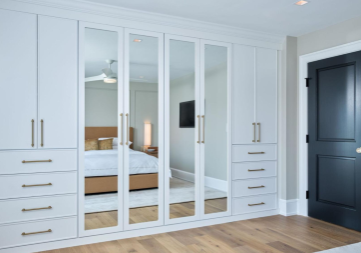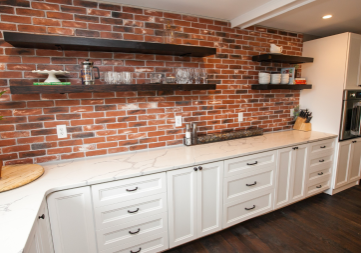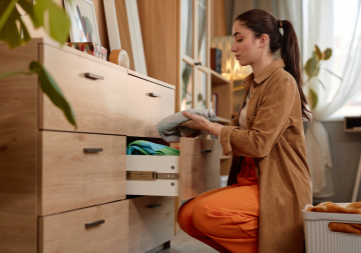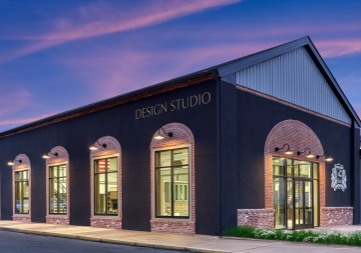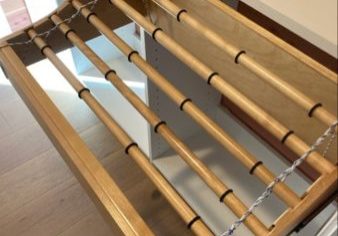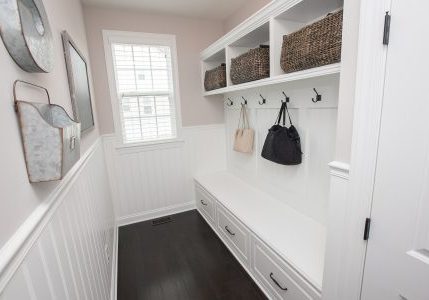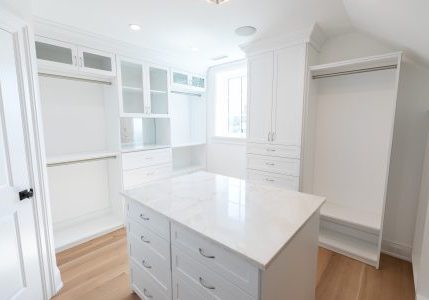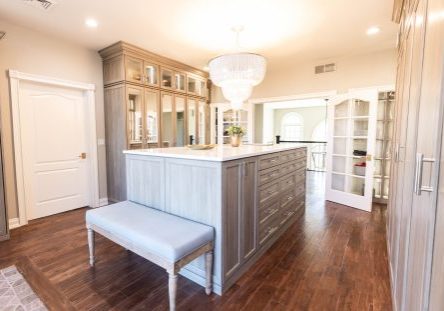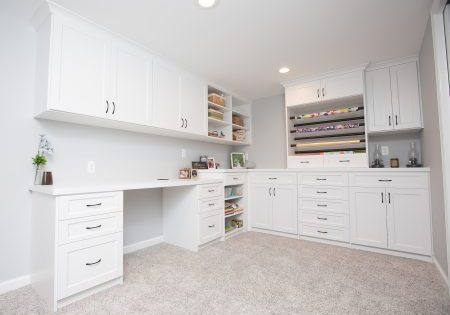Choosing the right color for your closet components is one of the most crucial aspects of closet design. Selecting the best closet colors for your space means considering how your closet will complement or contrast the surrounding area, how the colors will interact with your lighting systems, and what options are available from your closet design partner.

Color Theory for Closets
Color plays an impactful role in attractive designs of all sorts, so it’s best to treat color selection for closets with the same care you would in any other room in a home. Let’s explore some of the general principles of color theory and interior design to provide a framework for your closet color choices.
Understanding Color Psychology
When you’re searching for the best closet colors, it will serve you well to have some knowledge of how the colors you select can affect your thinking.
- Warm Colors (Red, Orange, Yellow): These colors are often perceived as more energizing and can create a welcoming atmosphere. They tend to stimulate feelings of excitement and warmth but could overwhelm if overused in a small space like a closet. Warm colors can be utilized tastefully as accent colors in certain components that pop when overlaid on neutral backdrops.
- Cool Colors (Blue, Green, Purple): Often associated with tranquility and calmness, cool colors can make a closet feel more open and serene. Soft blues or greens work especially well against natural lighting. These colors can find equal utility as wall colors and component colors. If the closet walls are patterned, accents of solid cool colors on shelving or drawers can provide areas of rest for the eye.
- Vivids and Pastels: Beyond the warm/cool distinction, the vividness of the hues you choose can change the way the colors are perceived. Darker and richer colors draw more attention, while paler, pastel colors can work to temper the boldness of your color choices. Consider the difference between a room painted in a strong burgundy and one painted in a soft pink. Both colors are based on red, but the presentation is totally altered by the color’s value.
Complementary and Secondary Colors
Selecting the best closet colors means striking a balance between integration and distinction. Oftentimes, homeowners prefer their closets to be less eye-catching than the surrounding room, allowing the space to feel cohesive and unified. This approach ensures that the closet serves its functional purpose without drawing excessive attention away from the main area. The best way to achieve this balance is by picking colors that mesh well with the colors of the room. Known as secondary colors, colors nearby on the color wheel (think yellow and green or orange and red) feel more “at home” in their surrounding color environment.
However, there is also opportunity for flexibility in your color choices. In certain cases, opting for bolder colors that create a contrast with other areas of the home can introduce an element of surprise and personality to your closet design. Complementary colors, or colors on the opposite end of the color wheel from each other, stand out in a major way. For instance, implementing a vibrant, complementary accent color (think orange on blue or purple on yellow) on the closet doors or interior shelves can create a striking visual contrast that enhances the overall aesthetic of the room. Ultimately, the pathway to creating a stunning closet lies in the careful exploration of both subtle and bold contrasts.
Neutrals and Natural Finishes
We’ve looked at the impact of color, but it’s equally important to understand the place for absence of color. Neutrals and natural finishes can be quiet heroes in a thoughtfully designed closet. These elements not only create a comfortable and timeless aesthetic but also offer versatility that adapts to evolving styles and trends.
The Power of Neutrals
Neutrals—such as white, gray, beige, and taupe—carry a unique ability to open up spaces, creating the illusion of more room without overpowering the existing decor. These colors serve as a blank canvas, allowing customers to showcase their personal items, like clothing and accessories, or enhance the effect of splashes of color or patterning. A neutral palette can help a closet appear sleeker and more organized, fostering a sense of calm that is especially welcome in smaller spaces. Neutral colors are also more adaptable, able to seamlessly work with many different colors—perfect for homeowners who like to continually refresh or personalize their spaces beyond the initial design.
Embracing Natural Finishes
Natural finishes, such as wood, stone, or matte textures, add an organic, tactile appeal to your color selection for closets. Electing for wood elements can evoke warmth and coziness while presenting a classic look. For example, lighter woods like maple or oak can bring brightness to the space, while darker woods like walnut or mahogany add depth and richness. Natural wood colors are also very adaptable but still require careful consideration to best mesh with the other stylistic choices in the space. Lighter woods work well with pastels, while darker woods can look amazing when placed alongside a complementary hue.
The Power of Black in Closet Design
When it comes to interior design, black holds a distinctive and commanding presence that can transform an ordinary storage space into a chic and sophisticated sanctuary. The versatility of black allows it to be used in a plethora of ways, making it a staple choice for many modern interiors. Whether you opt for a full black cabinetry or black accents, this choice brings a sense of timelessness that won’t easily go out of style.
Using black in combination with lighter colors can augment visual interest and depth. For instance, pairing black shelves with white walls can create a striking contrast that draws the eye. This design technique also helps to highlight other elements in the closet, such as colorful clothing or unique accessories. By using darker shades of gray and black in a closet, you can evoke a sense of seamlessness and organization. Well-integrated black in the closet design can prevent the eye from being distracted by visual clutter, maintaining a clean and sophisticated look.
Not every black color is the same; the nuances in black values and finishes can significantly influence the overall vibe of the closet. In much the same way that white can feature undertones of other shades, you should always be aware of how the lighting in your space can alter the appearance of black components and what tones may be brought out from your black through different lighting schemes. Make sure to always use your best judgement; black can become just as overpowering as any other color choice if it isn’t part of a thoughtful design.
Lighting and Color Combinations
Different types of lighting can produce varying atmospheres and either enhance or diminish the beauty of your chosen colors. Consider your lighting carefully, it may alter your color selection.
1. Natural Light
Natural light, sourced from windows and skylights, can bring out the true essence of colors. During the day, sunlight can illuminate a closet, making colors appear vibrant and true-to-life. However, it’s important to consider the variance in lighting that occurs depending on the time of day; morning and twilight sunlight has a cooler tone, while afternoon sun is often warmer and more yellow or golden. This is also affected by the type of glass used in the window that lets the light in. At night, the level of natural light is greatly diminished, so you’ll need to integrate other lighting systems as well, which should coordinate with the rest of the closet design.
2. Warm Artificial Lighting
Warm lighting, typically emitted by incandescent bulbs or warm LED lights (ranging from 2700K to 3000K), generates a cozy and inviting atmosphere. This type of lighting enhances warm hues, making colors like beige, soft browns, and warm whites look even more alluring. When using warm artificial lighting, colors may appear richer and more saturated, which is ideal for facilitating a comfortable, welcoming closet environment. However, some colors—especially cooler shades—may lose their character under warm lighting.
3. Cool Artificial Lighting
Cool lighting provides a more modern and crisp ambiance, often found in LED lights with a color temperature of 4000K and above. This type of lighting highlights cooler tones and can significantly shift how warm colors are perceived. For example, a light gray could take on a bluish tint, while warmer neutral tones may become less appealing and softer colors can feel flat. With so much to consider, color selection for closets can be difficult—but there’s an easy way to access a range of custom color options and high-quality materials.
Team up with Diplomat Closet Design for Colors You Will Love
The best way to make sure your next project exceeds expectations is to partner with Diplomat Closet Design for all your closet design needs. Our expert designers can guide you through all of your color selections and draw on a wealth of experience to make sure your design meshes well with your personal aesthetic and your budget.
Ready to get started? Request your free consultation today!


